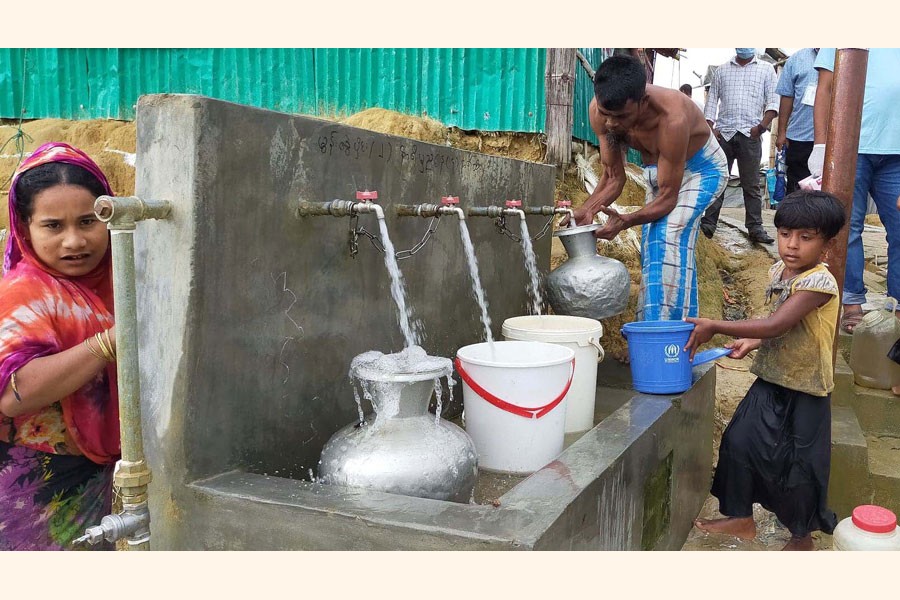
Published :
Updated :

Since August 2017 over 700,000 Rohingya refugees arrived in Cox's Bazar from Myanmar's Rakhine State and settled in refugee camps. More than a half of them are women and girls, 55 per cent are children under 18.
Many arrived injured and deeply traumatised by their experiences, with just the clothes on their backs. They needed food, clean water and shelter to survive.
The WASH conditions in these camps are still challenging and there is always a risk of outbreak of diseases. During the initial influx, shallow tube wells were installed 100-150 metres beneath the surface. Later deep tube wells (DTW) were drilled 500-800 metres deep. But water layers dried up causing water scarcity.
Eighty-seven per cent of households depend on tube wells for water. Refugees have to wait in long queues (more than 30 minutes) for water, and walk long distances.
According to the JRP midterm evaluation, whereas 98 per cent of women, men and children have access to safe drinking water, 56 per cent of refugee households have water access challenges including distance and queuing time.
After analysing different options for a sustainable water distribution system in the Rohingya refugee camps, in June 2018 it was decided among a group of experts from IOM, UHNCR, UNICEF, DPHE and Oxfam that the water network would consist of a number of individual systems non-connected between them.
Each of this system will supply water to a different number of population. To avoid gaps and overlapping, the water distribution system implementation will be organised by areas or zones, "Water Distribution Zone" (WDZ).
Accordingly, a Master Plan has been developed for 26 camps consisting of 138 WDZs. As part of the Sector Master Plan (WASH sector Cox's Bazar) implementation, UNICEF has set a target to install 46 Water Distribution Zones (WDZs) in seven camps through partner NGOs.
Asia Arsenic Network (AAN) conducted a project titled "Improvement of Existing Water Supply Systems in Rohingya Refugee Camp No. 8E in Cox's Bazar" under the partnership with UNICEF Bangladesh where DPHE provided technical support to fulfill Sector Master Plan recommendations.
The CiC (Camp In Charge) office confirmed the need assessment for WDZ and arranged necessary working environment inside the camp 8E. The Refugee Relief and Repatriation Commissioner (RRRC) approved the project to conduct activities. Under this project AAN installed three piped water supply systems.
An inauguration ceremony was held on October 29, 2020 for three piped water supply systems constructed at Rohingya camp 8E for refugees and people of nearby local community. The ceremony was jointly inaugurated by Sheikh Hafizul Islam, Deputy Secretary and Camp in Charge (CiC) of camp 8E, Md Ahosan Habib, Senior Assistant Secretary and Assistant CiC of camp 8E, Aynul Huda, WASH Officer of UNICEF Cox's Bazar, and representatives of Asia Arsenic Network Bangladesh led by Prof Sheikh Akhtar Ahmad, Chairman, with Dr Md Eklasur Rahman, Director, and Md Mizanur Rahman, Director. Members of the camp management team including Dutch Refugees Council, focal NGOs of World Vision and VERC also participated in the ceremony.
These piped water supply networks have capacity to supply 36,000,000 litres of water per day to about 17,000 Rohingya refugees. Currently, water is supplied two times every day. The water supply networks are run by solar power through a 15.80 KW solar panel system for 8E.02 and 8E.03(A) water distribution zones (WDZ) and a 13KW system for WDZ.8E.04.
For each of three production wells a 7.5 KW pump with 60m head is used. To ensure bacteria-free water an automatic chlorine dosing system is installed and used and residual chlorine is regularly monitored at different water points by testing with field kits.
In the inauguration ceremony Sheikh Hafizul Islam, CiC of camp 8E, said, "Ten water networks of this type are needed in this camp but at this moment there are only five including these three. These networks have been constructed nicely and I appreciate AAN and UNICEF for the work, which can serve as a model. It is worth mentioning that AAN kept a water hydrant at each washout point of the water networks to assist firefighters, which I truly and especially appreciate."
"I request the AAN to explain these hydrants to the refugees and train them on how to use them. Finally I would like to express my thanks to all those who were involved in this project and worked to install the water networks under the current COVID-19 situation," he added.
Aynul Huda, WASH Officer of UNICEF Cox's Bazar, said, "AAN is one of our partners. When we got an implementing partner like AAN our work load declines a lot. Before this project our team visited the Gowainghat piped water supply system which was constructed by AAN under the partnership with UNICEF. We recognize it as an excellent work which should be replicated all over Bangladesh."
"We value AAN's honesty and commitment along with good efforts by the field staff. AAN should value this and try to expand its working areas with humanitarian response in perspective, which will give us more opportunity to include AAN for camp activities," he further said.


 For all latest news, follow The Financial Express Google News channel.
For all latest news, follow The Financial Express Google News channel.